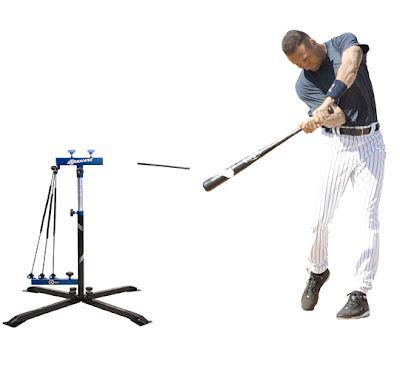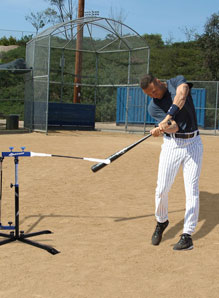
Order your new CAT 4 Hurricane Machine Now! It is baseball's #1 best selling hitting machine!
Derek Jeter Series - Just #179.95Youth Baseball Digest - 11 Simple Batting Terms Every Tee Ball and Little League Coach Should Know
By Nick Dixon
1. Grip - The first thing every young player must be taught is how to properly grip the bat. The bat is gripped with the "knocking knuckles" on the top and bottom hands aligned perfectly in a straight line with each other. The purpose of this grip is to place the bat handle in the fingers away from the palms of the hands. This grip allows the hands to be move quicker and to have maximum control of the bat. Tension is a batters worst enemy when it comes having a quality swing. Gripping the bat improperly often causes tension throughout the body. A relaxed grip on the bat allows the batter to react with better bat speed and hand quickness. Feeling relaxed at the plate is a key to a batters confidence.
2. Stance - A batters stance is how a batter initially stands in the batter's box to look out at the pitcher. A batter's stance is the position of the hands and feet prior to the start of the swing. The feet should be shoulder width apart with toes pointing toward the plate. The feet should be square to the plate. Square to the plate means that they are an equal distance from the plate. The stance also refers to the position of the hands and the angle of the bat. The hands should be no more that several inches from the shoulder. The stance should comfortable and should allow the batter to look at the pitcher with ease.
3. Stride - The term refers to the batters weight shift or step prior to the swing. The stride should be short and only about three to four inches if the front foot moves. Many batters simply pick the front foot up and replace it without moving it forward. If a step is taken, it should be a little step forward with the toes pointing toward the pitcher. It is important to teach young players that they must stride to get ready to hit. They do not stride to hit, but rather, they should stride to get ready to hit. The batters stride foot should be set before the pitchers front foot lands.
4. Hip Turn - Hip turn refers to the process of a batter generating power by driving the hips through a power rotation. Only pitches over the middle and inside 3rds of the plate allow a batter to get full hip turn. The closer the pitch is to the batter, the more hip turn is needed to properly hit the ball. Pitches on the outer part of the plate require little hip turn to hit. The hitter will rotate his hips open farther on an inside pitch than an outside pitch. The batter should rotate the hips on a level plane. Player should not lean forward over the plate or lean back away from the plate. The batter's back foot must pivot in order to have good hip rotation.
5. Balance - A batter must have good balance to be successful. Balance refers to proper weight distribution prior, during the swing, and at the finish of the swing. Good balance allows the hitter to have more control at the plate. Good balance begins with even weight distribution with a proper stance. The batters ability to control the body during the stride is the key to good balance.
6. Bat Speed - The speed of the bat during a swing. The bat the batter used must be the correct length and weight for a batter to generate optimum bat speed.
7. Squash the Bug - This term refers to the pivot the back foot during the baseball swing. This foot action allows the hips to open up or turn.
8. Shoe Laces to Pitcher - The best back foot action is not a squashing action with downward pressure. The best motion is to turn the back foot with the shoelaces toward the pitcher. This turn should be performed with a "light-weight" pivoting motion with little downward pressure. The batter pushes off from the ball of his rear foot to shift weight to the front side. Putting downward pressure on the ball of the back foot as it pivots and the hips rotate tends to constrict the quickness and power swing.
9. Trigger - Load - Both have the same meaning. Batters must learn to trigger or load to get ready to hit. The loading or triggering process is a batter's final movement of the body and hands to the optimum bat launching position to get ready for the swing. Different batters use different movement as a triggering mechanism. Many batters turn the front knee and should slightly inward. Other batters simply take the hands slightly up and back to what they call their launch position. The loading or triggering action should be a very slight movement.
10. A, B, C Baseball Swing - The "A, B, to C baseball swing" means a baseball swing that is not fundamentally correct. The term describes a swing that is not compact and not direct to the ball. The batter sweeps the bat in a slow long arch.
11. A to C Swing - Used to refer to a sort compact swing that take the bat from the "A" launch position directed to the "C" or contact position. The perfect baseball swing is a short compact "A to C" Swing.
For more articles on coaching baseball visit the Youth Baseball Digest, Little League Digest and the Baseball Coaching Digest.
The CoachesBest Baseball Store has a great selection of 1400 Baseball Products. Check out the BatAction Hitting Machine baseball pitching simulator. This high speed training machine is 100% Guaranteed to raise Batting Averages and has a full year warranty.
Nick Dixon is the President and founder of Nedco Sports, a sports training company established in 1999. Dixon is also an active and full time high school baseball coach with over 25 years experience. Coach Dixon is better known as the inventor of the BatAction Hitting Machine, the SKLZ Derek Jeter Hurricane Hitting Machine, the SKLZ Target Trainer, the SKLZ Derek Jeter ZipnHit Pro, and the SKLZ Strikeback Trainer. Dixon is also a contributing writer for BaseballCoachingDigest, the Youth Baseball Digest, the Baseball Parent Guide, the Baseball 2Day Coaches Journal, and Blog4Coaches.
Article Source: http://EzineArticles.com/?expert=Nick_Dixon

Order your new CAT 4 Hurricane Machine Now! It is baseball's #1 best selling hitting machine!
Derek Jeter Series - Just #179.95





















